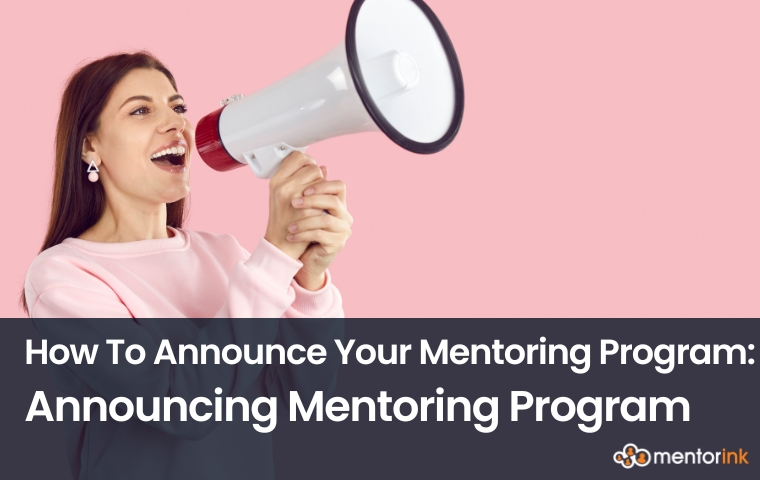
Launching a mentoring program inside an organization can be one of the most powerful initiatives you roll out. Done right, it helps employees grow, strengthens leadership pipelines, and creates a culture of support and learning. But the key to success is not about designing a mentoring program. As a founder of a mentoring program, you should make sure the right people know about it, understand its value, and feel inspired to participate. That starts with announcing the mentoring program. Announcing your mentoring program cannot be considered a matter of sending a memo or adding a blurb to the intranet. It requires strategy, timing, and the right messaging to generate excitement.
Before announcing your mentoring program, it is important that the program you have prepared is suitable for your target audience. “Things to Consider During Your Mentoring Program” will provide you with a roadmap.
How to Reach Right Audience by Announcing Mentoring Program
You might have the best-designed mentoring program in the world, but if the announcement misses the mark, you will not get the engagement you are hoping for. That is why identifying and reaching the appropriate audience is the first step.
Consider this: mentoring thrives when people believe it is tailored to them. If your announcement is too broad, it may get lost in the noise. If it is too narrow, you risk excluding people who would benefit. So, how do you strike the balance?
Segment your audience: You should decide if your mentoring program is open to everyone or designed for a specific group like new employees, managers, women in leadership, or first-generation college students.
Use the right channels: Younger audiences might respond well to social media announcements, while corporate teams might prefer email or intranet updates.
Speak their language: Frame the program in a way that highlights how it solves their problems or helps them grow. For example, an early-career professional might care about skill-building, while a senior leader might be motivated by giving back.
Once you know who you’re targeting, announcing your program becomes much more intentional and far more effective.
How to Announce Your Mentoring Program
Think of your announcement like launching a new product. You do not just flip a switch and hope people notice. You can build excitement, share the news in a way that grabs attention, and keep the energy going with follow-ups.
The message for announcing the mentoring program should be clear, motivating, and easy to act on. Employees should leave knowing what the program is, why it matters, and exactly how they can get involved. You can keep the tone friendly and approachable, like no jargon, just genuine communication about growth and opportunity.
Also, plan it in stages. Instead of one big reveal, create a flow of touchpoints: start with buzz from early champions, follow with a leadership email, back it up with a social media or intranet push, and then reinforce it during the next all-hands. This layered approach keeps the program front and center, making it harder to miss and easier to join. Before announcing your mentoring program, it is very crucial to ensure having an effective mentoring program. In order to give ideas about how managers can tailor your mentorship program they can look this content: “How Program Managers Ensure Effective Mentoring Programs“
Finding Champions for Your Mentoring Program
Champions can be considered the secret weapon for any successful program launch. These are the people who can authentically spread the word, lend credibility, and make the program feel real rather than just another corporate initiative.
Champions can be executives, but they do not always have to be. In fact, peers or respected mid-level leaders often carry more weight because employees see them as relatable.
Imagine hearing about the mentoring program from a senior VP you rarely interact with versus a well-regarded team lead who talks about how mentoring shaped their own career. The latter often resonates more.
When identifying champions, look for people who are enthusiastic about mentorship already. Maybe they’ve informally guided new hires, spoken openly about the mentors who shaped them, or shown interest in leadership development. Ask them to share their story in announcements, testimonials, or short videos.
Champions can also help answer questions and calm hesitations. Some employees may worry about the time commitment or whether they’re “qualified” to be a mentor. A champion who says, “I did not suppose I had time, but the program made it manageable,” or “You do not need to be a VP to mentor but you just need experiences worth sharing” can make participation feel more accessible.
Announcing Mentoring Program via Social Media or E-mail
Email remains one of the most reliable ways to announce a mentoring program because it allows you to control the message and reach employees directly. But you do not treat it like another routine HR email that people skim and delete. You have to craft the message carefully. By selecting a clear subject line that signals opportunity, like something like “Grow Your Career: Join Our New Mentoring Program” rather than “HR Announcement: Mentorship Initiative.”
The email should open with a hook, briefly describe the program, and highlight benefits. Add a call to action that tells employees exactly what to do next, whether that is signing up through a platform, filling out an interest form, or attending an info session.
Beyond email, social media can also be a powerful tool, especially if your program is open to external participants such as alumni, partners, or industry peers. A LinkedIn post from a senior leader or your company page can spark interest and show your commitment to development. Short video clips where employees share why mentoring matters to them can create authentic engagement.
Announcing Mentoring Program via Intranet
The intranet often becomes the central hub for program details, resources, and sign-ups. While it should not be the only place you announce the program, it is an important anchor. Using right way will increase engagement of employees to mentoring program.
The announcement here should be more detailed than an email or quick chat post. Include FAQs, timelines, expectations, and clear instructions for how to participate. Visuals help like use photos, infographics, or even a simple step-by-step guide that makes the process easy to follow.
One mistake to avoid is burying the announcement in a corner of the intranet that few people see. Make sure it is featured prominently on the homepage or highlighted in a banner. Tie it into other intranet content perhaps an interview with a program champion, a spotlight story on mentorship, or a short article on the value of peer learning. The more visible it is, the more likely employees will engage.
Using Method of the All-Hands
The all-hands meeting is one of the most powerful platforms for program announcements because it reaches everyone at once and carries the authority of leadership. An announcement here signals that the mentoring program isn’t just another HR initiative.
The key is making it memorable. Do not let it be a rushed mention at the end of the agenda. Dedicate time to explaining why the program exists and what it means for the organization. Share a story like a leader who benefited from mentoring or an employee who grew because of it. Personal stories stick far more than generic talking points.
If possible, have multiple voices involved in the announcement. A senior leader can speak to the strategic importance, while a program champion can share their personal perspective. Add a quick visual—maybe a short video teaser or a simple slide that outlines the steps to join.
Following the all-hands, reinforce the message immediately. Send out a recap email with a link to sign up. Post the recording for anyone who missed it. Keep the energy alive by ensuring people know exactly how to act on what they just heard.
Power of Personal Meeting
In the end, nothing beats the power of a personal conversation. For employees who may be hesitant or unsure, hearing directly from a manager, colleague, or mentor makes all the difference.
Personal meetings can take many forms. A manager might bring up the program in a one-on-one, encouraging an employee to join because they see potential in them. Peer conversations in team meetings can normalize participation: “I just signed up as a mentor—I think it’s going to be great.” Even informal chats, where someone shares why they’re excited, carry weight.
These conversations matter because they make the program feel personal rather than institutional. Instead of hearing “the company wants me to join,” employees hear “someone I respect thinks this could benefit me.” That distinction can move the needle from curiosity to action.
To make the most of this channel, equip managers and champions with talking points. Provide a simple overview of the program, answers to common questions, and examples of how to encourage participation. The easier you make it for them, the more likely they’ll spread the word in meaningful ways.


